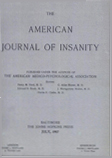Abstract
Acute, intermittent and recurrent convulsive seizures have been induced in monkeys by the application of discs containing various immunologically and chemically active substances to the cerebral cortex overlying the motor area. Acute seizures were either single attacks, or a series which usually terminated within one week of onset. Intermittent seizures occurred at widely-spaced intervals over a period of weeks or months. Recurrent seizures were frequent in occurrence (often daily) and persisted for many months. The seizures induced were either typically Jacksonian in nature, or generalized, and usually lasted one-half to two minutes. During unilateral seizures the attack was confined to the muscle groups on the side of the body contralateral to the treated cerebral hemisphere. Seizures occurred either spontaneously, or were induced by external stimuli.
Egg-white placed on the brain of monkeys generally sensitized to egg-white, or egg-white injected intravenously into animals in which egg-white had previously been applied to the cortex, yielded acute seizures. Egg-white, egg-white followed by anti-egg-white rabbit serum, specific antigen-antibody precipitates, and typhoid vaccine proved to be effective agents in the production of intermittent seizures.
Hydrous oxides of aluminum, alone or in combination with various proteins, invariably produced convulsive seizures, often recurring for many months (in one instance for more than one year to date). These recurrent seizures were of special interest since they represented a state of chronic convulsive reactivity.
Control preparations of aquaphor, alone or in combination with rabbit serum, monkey serum or gelatin, or empty discs failed to induce seizures.
Electric shock revealed a lowered threshold of convulsive reactivity of one motor area as compared with the other in monkeys exhibiting either unilateral or predominantly unilateral seizures.
Electroencephalography indicated that the greatest degree of abnormality in monkeys with convulsive seizures was observed in the precentral cortex and the immediately surrounding area. The recordings also established differences between the two motor areas which were correlated with differences in the clinical manifestations observed on the opposite sides of the body. Luminal and dilantin were found to reduce the incidence of the recurrent seizures produced.
Serologic studies revealed no correlation between the concentration of serum precipitins or agglutinins and the occurrence of seizures. Brain antibodies were not demonstrable.
The histopathologic findings were of two main types: (1) an acute, destructive process; (2) a chronic, proliferative type of response. The acute lesion was usually associated with the acute or intermittent convulsive seizures produced by immunologic agents. The chronic pathologic response was found in monkeys treated with alumina, aquaphor preparations or empty discs, and was not pathognomonic of the convulsive state.
Repeated convulsive seizures have been produced by a single application of various types of substances to the cerebral cortex. Although the mechanism remains obscure, the methods employed may prove useful in further studies of the nature of the convulsive state.

